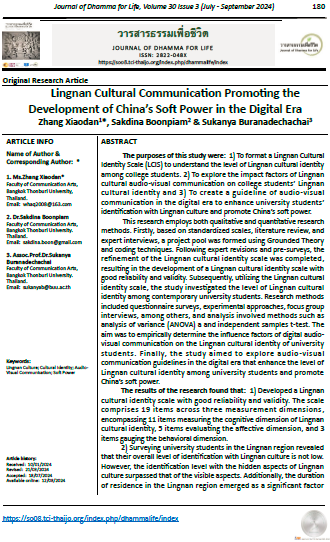Lingnan Cultural Communication Promoting the Development of China’s Soft Power in the Digital Era
Main Article Content
Abstract
The purposes of this study were: 1) To format a Lingnan Cultural Identity Scale (LCIS) to understand the level of Lingnan cultural identity among college students. 2) To explore the impact factors of Lingnan cultural audio-visual communication on college students’ Lingnan cultural identity and 3) To create a guideline of audio-visual communication in the digital era to enhance university students’ identification with Lingnan culture and promote China’s soft power.
This research employs both qualitative and quantitative research methods. Firstly, based on standardized scales, literature review, and expert interviews, a project pool was formed using Grounded Theory and coding techniques. Following expert revisions and pre-surveys, the refinement of the Lingnan cultural identity scale was completed, resulting in the development of a Lingnan cultural identity scale with good reliability and validity. Subsequently, utilizing the Lingnan cultural identity scale, the study investigated the level of Lingnan cultural identity among contemporary university students. Research methods included questionnaire surveys, experimental approaches, focus group interviews, among others, and analysis involved methods such as analysis of variance (ANOVA) a and independent samples t-test. The aim was to empirically determine the influence factors of digital audio-visual communication on the Lingnan cultural identity of university students. Finally, the study aimed to explore audio-visual communication guidelines in the digital era that enhance the level of Lingnan cultural identity among university students and promote China’s soft power.
The results of the research found that: 1) Developed a Lingnan cultural identity scale with good reliability and validity. The scale comprises 19 items across three measurement dimensions, encompassing 11 items measuring the cognitive dimension of Lingnan cultural identity, 5 items evaluating the affective dimension, and 3 items gauging the behavioral dimension.
2) Surveying university students in the Lingnan region revealed that their overall level of identification with Lingnan culture is not low. However, the identification level with the hidden aspects of Lingnan culture surpassed that of the visible aspects. Additionally, the duration of residence in the Lingnan region emerged as a significant factor influencing Lingnan cultural identity. Experimental studies indicated that digital Audio-visual Communication significantly enhances contemporary university students’ identification with Lingnan culture.
3) Established an ‘historical narrative + digital strategy’ Audio-visual Communication model to elevate the level of Lingnan cultural identity among college students, thereby contributing to the advancement of China’s soft power.


